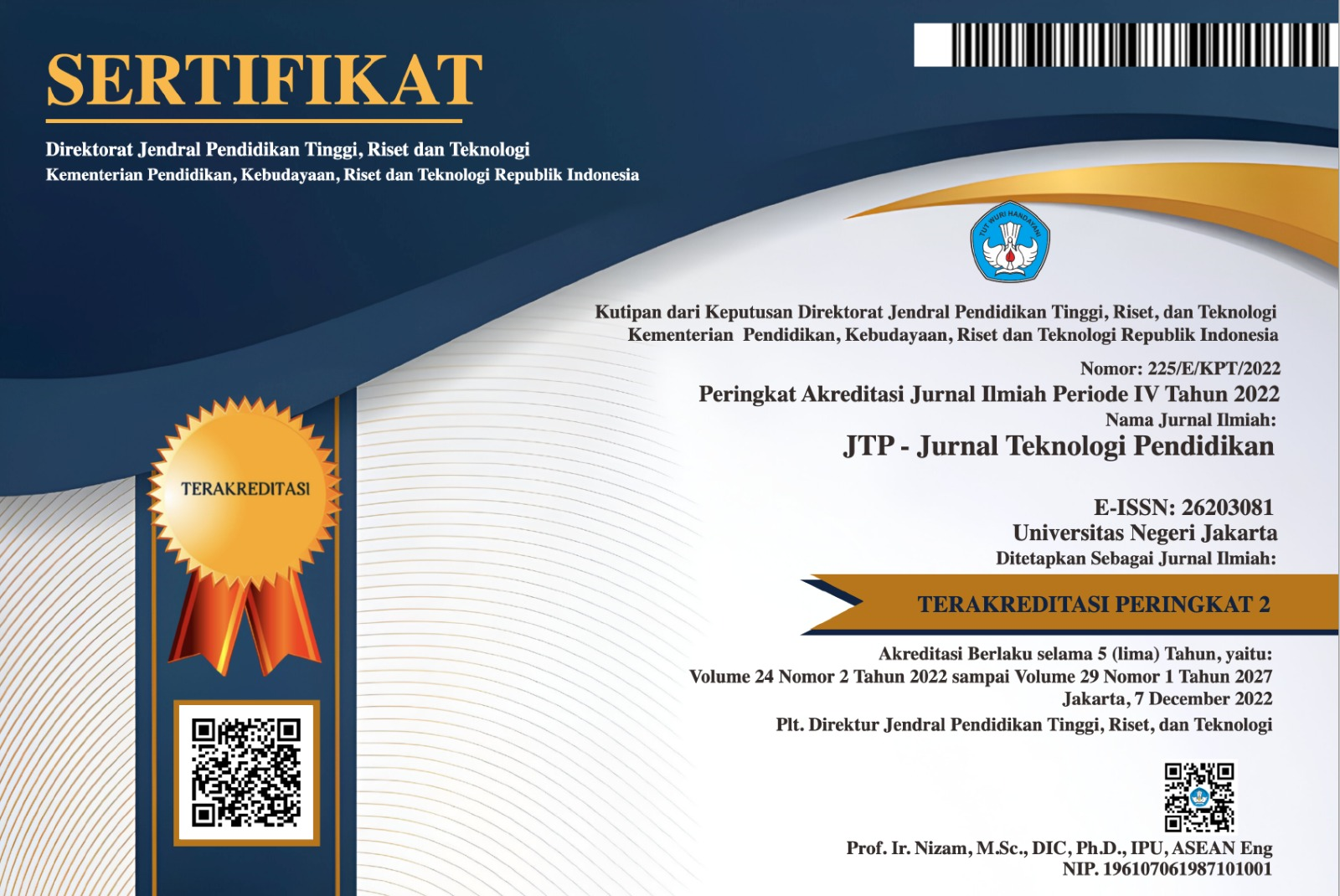The Relationship of Student Learning Discipline and Learning Outcomes in The Indonesian Language Subject Class V of Elementary School
DOI:
https://doi.org/10.21009/jtp.v26i2.46365Keywords:
Learning Disciplines, Learning Results, IndonesianAbstract
This research aims to determine the relationship between learning discipline and Indonesian language learning outcomes for class V students at SD Negeri 1 Dendang. This research uses a quantitative approach with a correlation method. The sample was determined using a saturated sample technique or census with 39 students as respondents. Data collection techniques using questionnaires, documentation studies and interviews. To determine the level of relationship between learning discipline and learning outcomes, the Product Moment Correlation formula is used. From the calculation results, the rxy value is 0.923, which means it has a very strong relationship. The results of the hypothesis test obtained a significance value from the Coefficients table of 0.001 <0.05 and a t value of 14,565 > t table 2,026. through this test, it was concluded that learning discipline and Indonesian language learning outcomes had a positive and significant relationship so that hypothesis H1 was accepted, meaning that there was a relationship between student learning discipline and Indonesian language learning outcomes for class V SDN 1 Dendang.
References
Amaliyah, N. (2020). Strategi Belajar Mengajar. Gosyen Publishing.
Amaliyah, N. (2023). Development of Technological, Pedagogical and Content Knowledge Based Learning Media. 25(1), 107–116. https://doi.org/10.21009/JTP2001.6
Arikunto, S. (2018). Prosedur Penelitian Suatu Pendekatan Praktik. Rineka Cipta.
Damanik, W. S., Purba, N. A., Sianturi, C. L., Belajar, D., Belajar, H., & Korelasi, ; (2022). Hubungan Disiplin Belajar dengan Hasil Belajar Matematika Siswa di Kelas IV SD Negeri 091405 Sipintuangin Tahun Pembelajaran 2022/2023 Kata kunci. http://Jiip.stkipyapisdompu.ac.id
Darmadi. (2017). Pengembangan Model Metode Pembelajaran dalam Dinamika Belajar Siswa. Deepublish.
Depdiknas. (2006). Kurikulum Tingkat Satuan Pendidikan (KTSP) Untuk Sekolah Dasar/MI. Edisi 3. PT Bumi Aksara.
Fajrin, V. dan P. A. (2021). Bahasa Indonesia Sebagai Mata Kuliah Dasar. Tata Akbar.
Hamzah dan Djuaeni, M. N. (2021). Majas Konsep Dasar dan Klasifikasinya Dalam Ilmu Balagha. Academia Publication.
Isnaeni, M., Budiana2, S., & Rahamah3, M. (n.d.). HUBUNGAN DISIPLIN BELAJAR DENGAN HASIL BELAJAR MATEMATIKA.
Katolik Santo Thomas Medan, U., Efa Naibaho, D., Sipayung, R., & Sofia Tanjung, D. (2020). HUBUNGAN DISIPLIN BELAJAR DENGAN HASIL BELAJAR SISWA PADA MATA PELAJARAN MATEMATIKA KELAS V DI SD NEGERI 24 TANJUNG BUNGA. In SEJ (School Education Journal (Vol. 10, Issue 4).
Naadhiroh, F., & Amaliyah, N. (2023). Peningkatan Hasil Belajar IPS dengan Menggunakan Strategi Pembelajaran Team Quiz pada Kelas V Sekolah Dasar. Journal of Education Action Research, 7(3), 344–350. https://doi.org/10.23887/jear.v7i3.65239
Parwati, N. N. dkk. (2019). Belajar dan Pembelajaran. PT. Rajagrafindo Persada.
Pendidikan Islam dan Keguruan, F., Novita, L., & Maulida Akhsan, S. (n.d.). Jurnal PGSD UNIGA HUBUNGAN DISIPLIN BELAJAR DENGAN HASIL BELAJAR MATEMATIKA.
PERATURAN MENTERI PENDIDIKAN NASIONAL REPUBLIK INDONESIA. (n.d.).
Prastiyo, F. (2019). Peningkatan Hasil Belajar Peserta Didik Dengan Model Kooperative Jigsaw Pada Materi Pecahan di Kelas 5 SD. Kekata Publisher.
Publikasi pada Bidang Pendidikan Dasar, M. (2019). Ujiati Cahyaningsih Jurnal Cakrawala Pendas. 5(1), 45.
Rahmadi, R. T., Zulaihati, S., Susanti, S., Pendidikan Ekonomi, J., & Akuntansi, D. (n.d.). The Influence of Learning Discipline and Peer Environment on Learning Outcomes of Business Economy in Class X at One of SMK Negeri in Jakarta.
Santoso, I. dan M. H. (2021). Metodologi Penelitian Kuantitatif. Indigo Media.
Siregar, S. (2017). Metode Penelitian Kuantitatif. Kencana.
Siswa, P., Yang, F., Disiplin Belajar, M., Kelas, S., Tisaga, X. I., Jaya, P., Suharso, D., Bimbingan, J., & Konseling, D. (2018). Indonesian Journal of Guidance and Counseling: Theory and Application. In IJGC (Vol. 7, Issue 3). http://journal.unnes.ac.id/sju/index.php/jbk
Sobri, M. (2020). Kontribusi Kemandirian dan Kedisiplinan Terhadap Hasil Belajar. Guepedia.
Sugiarto. (2021). Mendongkrak Hasil Belajar Matematika Menggunakan PBL Berbantuan GCA. Yayasan Lembaga Gumun Indonesia (YLGI).
Sugiyono. (2017). Statistika Untuk Penelitian. Alfabeta.
Sugiyono. (2018). Statistika Untuk Penelitian. Alfabeta.
Sugiyono. (2019). Metode Penelitian Kuantitatif, Kualitatif, dan R&D. Alfabeta.
Suhartini, T., & Amaliyah, N. (2024). HUBUNGAN MOTIVASI BELAJAR DAN KETERAMPILAN BERPIKIR TINGKAT TINGGI (HOTS) SISWA TERHADAP HASIL BELAJAR ILMU PENGETAHUAN SOSIAL SISWA KELAS IV SD NEGERI DI JAKARTA SELATAN. Research and Development Journal Of Education, 10(1), 414–420. https://doi.org/10.30998/rdje.v10i1.22652
Supriyadi. (2018). Pengaruh Metode Pembelajaran dan Kecerdasan Emosional Siswa Terhadap Hasil Belajar. PT. Nasya Expanding Manajement.
UU RI No.9 tahun 2009 tentang badan hukum pendidikan pasal 1 ayat 9. (2009). Indonesia.
Yanti, P. G. dkk. (2016). Bahasa Indonesia Konsep Dasar dan Penerapan. PT Grasindo.
Yudha, R. P. (2018). Motivasi Berprestasi & Disiplin Peserta Didik. Yudha English Gallery.
Downloads
Published
How to Cite
Issue
Section
License
Copyright (c) 2024 Pira Oktarian

This work is licensed under a Creative Commons Attribution-ShareAlike 4.0 International License.
Jurnal Teknologi Pendidikan is an Open Access Journal. The authors who publish the manuscript in Jurnal Teknologi Pendidikan agree to the following terms.
Attribution-ShareAlike 4.0 International (CC BY-SA 4.0)
-
Attribution — You must give appropriate credit, provide a link to the license, and indicate if changes were made. You may do so in any reasonable manner, but not in any way that suggests the licensor endorses you or your use.
-
ShareAlike — If you remix, transform, or build upon the material, you must distribute your contributions under the same license as the original.
- No additional restrictions — You may not apply legal terms or technological measures that legally restrict others from doing anything the license permits.
Notices:
- You do not have to comply with the license for elements of the material in the public domain or where your use is permitted by an applicable exception or limitation.
- No warranties are given. The license may not give you all of the permissions necessary for your intended use. For example, other rights such as publicity, privacy, or moral rights may limit how you use the material.








